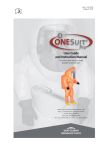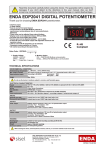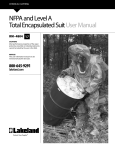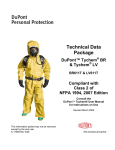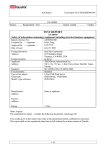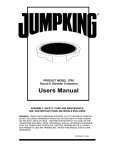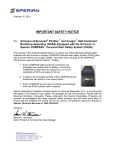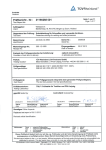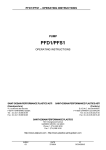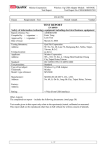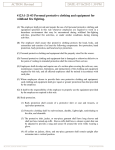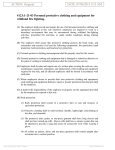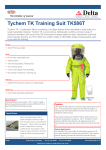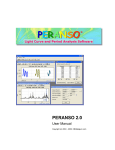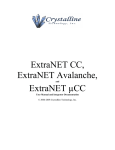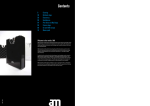Download ONESuit Flash and ONESuit Gard Protective Suits - Saint
Transcript
ONESuit® Flash and ONESuit® Gard User Guide and Technical Manual THIS USER INFORMATION IS TO BE REMOVED ONLY BY THE END USER A Singular Approach to Hazmat Protection Cert. Model – NFPA 1991 (2005 ed.) • Maximum safety and lightweight comfort • Full protection without a cumbersome over-cover • Single-skin convenience at a competitive price • ONESuit® Flash is certified to the Chemical Flash Fire Protection Performance under NFPA 1991 Table of Contents 1. Introduction to ONESuit® Gard and ONESuit® Flash p. 2 Compliance statements Description of materials 2. User Guide p. 4 A. Pre-Use Information Safety considerations Limitations of use Marking restrictions Shelf life Visor anti-fog procedure Recommended undergarments B. Preparation for Use Sizing p. 5 C. Donning/Doffing Information Donning and doffing procedures Recommended storage practices p. 6 D. Maintenance and Cleaning Information Cleaning instructions/precautions Inspection and pressure test details Glove replacement procedure Maintenance criteria Decontamination procedures Retirement and disposal criteria p. 7 3. NFPA 1991-2005 Edition Approval Data p. 9 4. Inspection Log p. 14 5. Disclaimers and Warnings/Warranty/ Limitation of Liability p. 15 1 SECTION 1: Introduction to ONESuit® Gard and ONESuit® Flash ONESuit® Gard is designed to meet the real-world needs of those who work in the most dangerous environments. ONESuit® Flash delivers the same benefits as ONESuit® Gard, plus additional protection against chemical flash fires. ONESuit® Gard and ONESuit® Flash offer: • Protection from exposure to chemical/biological agents and industrial chemicals in both liquid and vapor form • Flame and abrasion resistance without a separate over-cover; ONESuit® Flash offers chemical flash fire protection • Comfort, thanks to soft, lightweight fabric • Simplified donning and doffing • Ease of storage and handling due to lightweight, compressible design • ONEGlove® Hazmat glove system, offering outstanding protection with excellent dexterity • Interchangeable exterior visor that allows for replacement if visual acuity is impaired • Internal belting system that secures the suit to the body for increased mobility • Enlarged pod area to accommodate larger SCBA systems Compliance statements ONESuit® Gard and ONESuit® Flash are designed with the user’s absolute protection as the paramount goal. NFPA certification testing is conducted through the Safety Equipment Institute (SEI), and ONESuit® Gard and ONESuit® Flash are certified to the following standard: • NFPA 1991 – Standard on Vapor-Protective Ensembles for Hazardous Materials Emergencies (2005 Edition) - Liquefied Gas Option included - For ONESuit® Flash only: Chemical Flash Fire Option included NOTE: Proper use is consistent with NFPA 1500 – Standard on Fire Department Occupational Safety and Health Program, and 29 CFR 1910.132. Certified Model – NFPA 1991, 2005 ed. 2 ONESuit® Gard/ONESuit® Flash User Guide and Technical Manual • www.onesuittec.com Description of materials ONESuit® Gard and ONESuit® Flash use only materials that have passed the most rigorous testing. • Garment Material - Garment barrier fabric for ONESuit® Gard is Challenge® NXT. Garment barrier fabric for ONESuit® Flash is Challenge® NXT-F. They are manufactured using proprietary fluoropolymer films produced by Saint-Gobain Performance Plastics, which are then laminated to aramid substrates. • Visor Material - The ONESuit® Gard visor is constructed of two layers, primary (inner) and secondary (outer). The primary visor is made of 10-mil FEP and provides full chemical/biological agent protection. The secondary visor is made of clear 20-mil flexible PVC that attaches to the suit using nickel-plated snap fasteners and provides burst- and tearresistant properties. - The ONESuit® Flash visor includes ONESuit® Gard visor construction plus an additional layer of PFA film to shield the PVC during flash fire exposure. NOTE: The secondary visor MUST be worn with ONESuit® Gard and ONESuit® Flash. • Gloves - ONEGlove® Hazmat – by Saint-Gobain Performance Plastics. Outstanding protective gloves featuring single-piece construction and excellent dexterity. Available in the following sizes: • Small (7) – p/n 22410M • Medium (8) – p/n 22411M • Large (9) – p/n 22412M • X-Large (10) – p/n 22413M • XX-Large (11) – p/n 22414M • Closure - The closure consists of a vapor-tight zipper with garment material splash flaps that seal using hook-and-loop fastener strips. The zipper is installed for front entry; a 48" opening is created when the zipper is open. • Tape and pull material – PVC-coated polyester • Slider material – Alum. Bronze • Chain material – nickel silver • Attachments - All garment seams are stitchless. They are produced by heat welding, and then covered on both sides with fluoropolymer film. - Visor seam is a heat weld directly to the garment material. - Gloves are attached using a ring and clamp assembly. - Zipper is attached using thermoplastic adhesive film. • Exhaust Valves - The suits are equipped with two exhaust valves manufactured by Saint-Gobain Performance Plastics; they are attached to the suits using a plastic nut, two rubber washers and one metal washer. - The valve body is made from impact-resistant plastic, and the diaphragm is made from silicone rubber. - The valves are covered by flaps made from garment material. • Pass-thrus - The suits are available with optional SCBA pass-thru assemblies installed upon request when ordering. These pass-thru assemblies accommodate the following SCBA manufacturers: • Dräger • Interspiro • ISI • MSA • Survivair • Scott - Refer to the manufacturer’s instructions for information on a specific pass-thru. • Protective Helmet - The hoods of these suits are designed to be worn with an ANSI-style hard hat. • Boots - As an NFPA 1991 certified ensemble, ONESuit® Gard and ONESuit® Flash are to be worn with either Onguard Hazmax® or Tingley HazProof® protective boots. 3 SECTION 1: Introduction to ONESuit® Gard and ONESuit® Flash (continued) • Boots (continued) - The boots are worn over integral booties that are made of the garment material and connected directly to the suit. • The Tingley HazProof boots feature a fire resistant PVC alloy boot material with a steel toe, steel shank, and a steel mid sole incorporated within a sure grip cleated outsole; (p/n 82330, 82331, sizes 7-13). • The ONGUARD Hazmax boots feature a flexible PVC alloy boot material with a steel toe, steel shank, and a steel mid sole incorporated within an Ultragrip® Sipe Sole; (p/n 87007, 87012, 87015, sizes 6-15) SECTION 2A: User Guide Pre-Use Information Safety considerations All protective equipment needs to be well maintained in order to function properly. ONESuit® Gard and ONESuit® Flash are no exceptions. These suits must be decontaminated, inspected, and pressure-tested prior to use. Remove from service if the suits fail inspection or pressure tests. Users must read this guide thoroughly, and should take the following precautions into consideration: 1. Avoid direct flame contact. The suits are not intended for use in an open flame; however, ONESuit® Flash provides protection in the event of a chemical flash fire. 2. Avoid continuous exposure to any known hazardous substance. Do not purposely expose the suits to a constant liquid/vapor hazard. 3. If the following symptoms are experienced, the user MUST leave the “hot zone”: fever, nausea, dizziness, eye irritation, breathing difficulty, excessive fatigue, or any unusual odor or taste. NOTE: Most performance properties of these vapor protective ensembles or individual elements cannot be tested by the user in the field. Limitations of use These products are recommended for use as described in the standard to which they are certified. If it is suspected that these products have come into contact with a hazardous substance, follow appropriate departmental procedures for decontamination or disposal. Marking restrictions It is recommended that these products not be marked in any way by the user. The properties of the suit barrier material that make it highly resistant to chemicals also make it resistant to markings from paint, markers and pens. If marking is desired, please specify during the ordering process for permanent attachment of letters or numbers by the factory. Shelf life There is limited data for the materials within ONESuit® Gard and ONESuit® Flash. Based on experience with similar products in the field, Saint-Gobain expects a minimum shelf life of 15 years for both ONESuit Gard and ONESuit Flash based on specified storage conditions, maintenance, and testing practices. There is no need to dispose of the ensembles based strictly on time. Ensembles must be inspected and pressure-tested at least once a year. If there is any question about the condition of the products, discontinue use immediately. Visor anti-fog procedure The use of anti-fog solutions on the inside of the visor is not recommended. Instead, be sure to have access to a clean, soft cloth that may be used to wipe the inside of the visor in the event of fogging. Recommended undergarments Keep in mind that because ONESuit® Gard and ONESuit® Flash are fully-encapsulating garments, there is very little exchange of heat between the body and outside the suits. The most appropriate garments will depend on temperatures outside the suit and mobility demands of the mission. Wearing certain synthetic and/or natural fabrics against the skin will aid in comfort by moving moisture away from the body. 4 ONESuit® Gard/ONESuit® Flash User Guide and Technical Manual • www.onesuittec.com SECTION 2B: User Guide Preparation for Use Sizing ONESuit® Gard and ONESuit® Flash have been sized to fit a wide range of users. Please refer to the following table to assist in finding the appropriate size. NOTE: When determining suit size simply choose according to your height and weight; the suits are designed to accommodate a helmet, SCBA and other necessary equipment. ONESUIT® FLASH AND ONESUIT® GARD SIZES ONESuit® Flash product code ONESuit® Gard product code suit size ONEGlove® hazmat standard size recommended boot size 1S-F-SM 1S-A-SM Small 8 (Medium) 6-9 1S-F-MD 1S-A-MD Medium 9 (Large) 8-13 1S-F-LG 1S-A-LG Large 9 (Large) 8-13 1S-F-XL 1S-A-XL X-Large 10 (X-Large) 9-14 1S-F-2X 1S-A-2X XX-Large 10 (X-Large) 10-15 1S-F-3X 1S-A-3X XXX-Large 11 (XX-Large) 10-15 SIZE GUIDELINES suit size height (in.) weight (lbs.) Small 60 - 64 100 - 130 Medium 64 - 68 130 - 180 Large 68 - 72 140 - 210 X- Large 72 - 76 180 - 230 XX-Large 74 - 78 210 - 260 XXX-Large 76 - 80 240 - 290 These measurements are only guidelines. Please consult a Saint-Gobain Performance Plastics representative if unsure of your optimal size. 5 SECTION 2C: User Guide Donning/Doffing Information Donning and doffing procedures ONESuit® Gard and ONESuit® Flash are designed to be donned and doffed with great ease. • Refer to the sizing section to determine the appropriate size suit. • Be sure that the selected suit has passed inspection and pressure tests as required. • It is recommended that a person be available to assist during the donning and doffing process. • Be sure that there are no items on the body or clothing that could cause damage to the inside of the suit, such as rings, watches, badges, belts, etc. NOTE: When donning and doffing the suit take care to avoid creasing the visor, as this could impair visibility and/or create a leak failure in the suit. To don the suit: To doff the suit: 1. Choose a location that offers a clean place to stand and has either a bench or chair. 1. Reverse the order of steps followed when donning the suit. 2. While seated, place both legs into the suit with only socks over the feet. Insert feet into boots. Recommended storage practices ONESuit® Gard and ONESuit® Flash should be stored in a safe and dry location away from direct sunlight, with temperature maintained between 25ºF (-4ºC) and 110ºF (43ºC). The zipper should be completely open. The suit may be stored either in the supplied storage bag or on a hanger, and should always be stored with the zipper in the fully open position. Be sure to maintain inspection and testing at specified intervals, even when the suit has not been in use. 3. Stand up, and put the SCBA pack on while the suit is at waist level. It is recommended that the mask not be put on the face until the suit is ready to be zipped up in order to conserve air. Attach the internal belt to the waist, securing tightly to the body. 4. Put mask on face and turn on air supply. Put safety helmet on. 5. Pull suit over the head, being careful not to crease or crush the visor. 6. Zip suit completely closed, then close flap over zipper. NOTE: Use caution when folding and handling the suit to avoid creasing the visor, as this could impair visibility and/or create a leak failure in the suit. 6 ONESuit® Gard/ONESuit® Flash User Guide and Technical Manual • www.onesuittec.com SECTION 2D: User Guide Maintenance and Cleaning Information Cleaning instructions/precautions ONESuit® Gard and ONESuit® Flash should be cleaned after each use when they have been worn for routine operations but not subjected to chemical or biological contamination. For cleaning the suits, liquid dish washing detergent may be used along with a disinfectant at the ratio of 1 oz. each per gallon of warm water. Using a soft, clean rag, gently rub the cleaning solution over the inside and outside surfaces of the suit. Using a different soft, clean rag and warm water, gently rinse the entire suit. To dry the suit, either lay the suit out so that the inside and outside surfaces receive ventilation for drying, or place on a hanger. WARNINGS: Do not use bleach as cleaning detergent! Even though the garment material is completely resistant to bleach, other components, such as gloves, hook-and-loop fasteners, and secondary visors, may become damaged if exposed. Do not use the suit if not cleaned and thoroughly dried! each use, and at least once per year if the suit has not been in use. • Look over all areas of the suit for cuts or damage, including seams, garment material and visor material. • Confirm that gloves are securely attached to the suit. Inspect the gloves in accordance with the ONEGlove® Hazmat user guide. • Inspect the zipper for proper function, and that it is not becoming detached from the suit. If it requires more pull force than usual, rub paraffin wax over the teeth to provide lubrication. NEVER force the zipper, because this could damage the teeth and compromise the air tightness of the ensemble. • Verify that exhaust valves are in place, properly seated, and hand tightened. Use the following steps to pressure test the suit: 1. Remove the exhaust valves (quantity 2). 2. Install the pressure test adapters (optional parts) in the valve holes, with the hose connections facing outside of the suit. One adapter should have a large diameter hose and fitting, and the other a small diameter hose and fitting. NOTE: Use caution when cleaning the suit to avoid creasing the visor, as this could impair visibility and/or create a leak failure in the suit. 3. Close zipper to the fully seated position. Inspection and pressure test details A visual inspection and pressure test of these products must be performed and passed prior to COMMERCIALLY AVAILABLE PRESSURE TEST KITS CAPABLE OF TESTING TO ASTM F1052 MAY BE USED TO TEST ONESUIT® GARD AND ONESUIT® FLASH. REFER TO THE APPLICABLE PRESSURE TEST KIT OPERATING INSTRUCTIONS BEFORE PROCEEDING. 4. Inflate suit to a gauge pressure of 5" H2O and hold for 1 minute. This will pre-expand the volume inside the suit. DO NOT over-inflate the suit as that could damage the seams. 5. To perform the pressure test, reduce suit pressure to 4" H2O and hold for 4 minutes. Be careful not to touch or disturb the suit during the test period as this could create false test results. 6. The suit has passed pressure test requirements if ending pressure is greater than 3.2" H2O. It has failed if pressure is less than 3.2" H2O. 7. Record test results on the inspection log found in Section 4 of this guide. NOTE: Use caution when inspecting and pressure-testing the suit to avoid creasing the visor, as this could impair visibility and/or create a leak failure in the suit. CONTACT SAINT-GOBAIN PERFORMANCE PLASTICS IF THE SUIT FAILS INSPECTION OR PRESSURE TEST. IT IS POSSIBLE THAT THE SUIT CAN BE REPAIRED AT THE FACTORY. NOTE: ANY RETURNED SUIT MUST BE ACCOMPANIED BY COMPLETED SAINT-GOBAIN SUPPLIED FORMS TO CONFIRM THAT IT IS NOT CONTAMINATED. 7 SECTION 2D: User Guide Maintenance and Cleaning Information (continued) Glove replacement procedure If the gloves have been visibly damaged or worn, or cause the suit to fail the pressure test, then a replacement pair should be installed to keep the suit in operation. Use the following steps to remove and reinstall the gloves onto the suit: 1. Flip the elastic portion of the glove gauntlet over the glove ring. 2. Turn the sleeve of the suit inside out, and then remove the tape and rubber bands from over the clamp. 3. Remove the glove clamp by loosening the hex bolt; use only a socket connection, as other tools could accidentally damage the suit. Remove the rubber band from under the clamp. 4. Pull glove out of sleeve, then remove the glove ring. Be sure to retain the two rubber bands, glove clamp and glove ring if they are free of damage. Replacement parts are available if there is damage. 5. Fold the elastic portion of the glove toward the fingers so that the gauntlet of the inner liner is fully exposed and accessible. 6. Insert the glove ring into the replacement glove, then fold outside edge of the glove liner gauntlet to the inside of the ring so that the ring is tightly inserted. 7. Push the ring part of the glove first through the insideout sleeve until the edge of the sleeve is expanded over the ring portion of the glove. The sleeve seam should be centered in the palm area of the glove. 8. Adjust glove placement at the sleeve interface as necessary to remove wrinkles that could be trapped under the clamp area. NOTE: Wrinkles in the glove at the sleeve interface may cause the suit ensemble to fail pressure test if not worked out prior to clamp assembly. 9. Place the smaller rubber band over the sleeve at the glove ring interface. It should be centered on the ring, with the suit sleeve fully captured underneath. 10. Position the clamp centered over the rubber band so that the hex bolt is 180° opposite the suit sleeve seam. Again, use only a socket connection on the hex bolt to tighten the clamp. 11. Cover clamp with the large rubber band, then wrap rubber band area over the glove ring area with electrical tape to secure. Flip gauntlet end of glove from inside the ring out over the taped area. 12. Invert sleeve to turn right side out. Push glove ring securely into the end of the sleeve from inside the suit sleeve. DO NOT PULL ON THE GLOVE TO FORCE THE GLOVE RING INTO THE SLEEVE, AS THIS COULD DAMAGE THE GLOVE. Maintenance criteria At a minimum, the suit ensemble should be inspected and pressure-tested once a year. If there is any question about the condition of the product, discontinue use immediately. Please refer to “Inspection and pressure test details” on page 7 for complete instructions. Decontamination procedures Refer to departmental procedures for decontamination practices and procedures. ONESuit® Gard and ONESuit® Flash will withstand exposure to some chemical agents without degradation. Following decontamination, perform a full inspection and leak test on the garment to determine if it is suitable for continued use. Retirement and disposal criteria Refer to departmental procedures for disposal practices and procedures for these suits. 8 ONESuit® Gard/ONESuit® Flash User Guide and Technical Manual • www.onesuittec.com SECTION 3: NFPA 1991-2005 Edition Approval Data Certified Model – NFPA 1991, 2005 ed. PHYSICAL PROPERTIES AND GARMENT TESTS/ONESUIT® GARD AND ONESUIT® FLASH property method requirement Liquid Tight Integrity NFPA 1991 8.3 No penetration result Pass Ending Suit Pressure NFPA 8.4 ≥ 80 mm H2O 81.25 Accommodates Head Protection NFPA 8.4 Yes Pass Visual Acuity (Gard only) NFPA 8.4 ≥ 20/35 20/20 Remove/Reinsert Hands NFPA 8.4 5 times Pass Maximum Suit Ventilation Rate NFPA 8.5 Gas Tight Integrity ASTM F1052 ≤ 100 mm H2O ≥ 80 mm H2O 87.5 Exhaust Valve Mounting Strength NFPA 8.9 > 135 N 142.5 Fitting Pull Out Strength (Dräger Pass-thru) NFPA 8.13 > 1000 N 1323.5 91 Fitting Pull Out Strength (Interspiro Pass-thru) NFPA 8.13 > 1000 N 1317.1 Fitting Pull Out Strength (ISI Pass-thru) NFPA 8.13 > 1000 N 1321.4 Fitting Pull Out Strength (MSA Pass-thru) NFPA 8.13 > 1000 N 1329.4 Fitting Pull Out Strength (Survivair Pass-thru) NFPA 8.13 > 1000 N 1192.6 Fitting Pull Out Strength (Scott Pass-thru) NFPA 8.13 > 1000 N 1329.2 Exhaust Valve Inward Leakage NFPA 8.26 ≤ 30 ml/min 15 Flammability Resistance Afterflame – Garment Material (Gard only) ASTM F1358 ≤ 10 seconds 0.0 Flammability Resistance Char Length – Garment Material (Gard only) ASTM F1358 ≤ 100 mm 19 Flammability Resistance No Melt or Drip – Garment Material (Gard only) ASTM F1358 Up to 12 seconds Pass Burst Strength – Garment Material ASTM D751 > 200 N 408.95 Puncture Propagation Tear Resistance – Garment Material ASTM D2582 > 49 N 95.33 Cold Temperature Performance – Garment Material (Gard only) NFPA 8.12 ≤ 0.057 N x m 0.001 Seam Breaking Strength – Garment ASTM D751 > 2.88 kN/m 4.387 Closure Breaking Strength ASTM D751 > 2.88 kN/m 7.039 Flammability Resistance Afterflame – Visor Material ASTM F1358 ≤ 10 seconds 3.82 Flammability Resistance Char Length – Visor Material ASTM F1358 ≤ 100 mm 20.32 Flammability Resistance No Melt or Drip – Visor Material ASTM F1358 Up to 12 seconds Pass Cold Temperature Performance – Visor Material NFPA 8.12 No Crack or Visible Damage Pass Seam Breaking Strength – Visor ASTM D751 > 2.88 kN/m 4.027 Burst Strength – Visor Material ASTM D751 > 200 N 893.46 Puncture Propagation Tear Resistance – Visor Material ASTM D2582 > 49 N > 923.5 Overall Ensemble Inward Leakage NFPA 8.8 0.02% Pass PHYSICAL PROPERTIES AND GARMENT TESTS/ONESUIT® FLASH property method requirement result Overall Ensemble Flash Test – Afterflame NFPA 8.7 ≤ 2 seconds 0.0 Overall Ensemble Flash Test – Gas Tight Integrity ASTM F1052 ≥ 13 mm H2O 43.1 Overall Ensemble Flash Test – Visual Acuity NFPA 8.4 ≥ 20/100 20/25 TPP – Garment Material ISO 17492 ≥ 12 24.5 TPP – Visor Material ISO 17492 ≥ 12 23.7 TPP – Footwear ISO 17492 ≥ 12 55.7 Flammability Resistance Afterflame – Garment Material ASTM F1358 ≤ 2 seconds 0.0 Flammability Resistance Char Length – Garment Material ASTM F1358 ≤ 100 mm 14 Flammability Resistance No Melt or Drip – Garment Material ASTM F1358 Up to 12 seconds Pass Cold Temperature Performance NFPA 8.12 ≤ 0.057 N x m 0.009 Flammability Resistance Afterflame – Visor Material ASTM F1358 ≤ 2 seconds 1.4 Flammability Resistance Char Length – Visor Material ASTM F1358 ≤ 100 mm 51 Flammability Resistance No Melt or Drip – Visor Material ASTM F1358 Up to 12 seconds Pass 9 SECTION 3: NFPA 1991-2005 Edition Approval Data (continued) GARMENT MATERIAL PERMEATION (after Flex and Abrasion)/ONESUIT® GARD AND ONESUIT® FLASH chemical or biological agent method requirement result Acetone > 480 Acetonitrile > 480 Ammonia > 480 1,3-Butadiene > 480 Carbon Disulfide > 480 Chlorine > 480 Dichloromethane > 480 Diethyl Amine > 480 Dimethyl Formamide > 480 Ethyl Acetate > 480 Ethylene Oxide > 480 Hexane > 480 ASTM F739 Time to breakthrough 0.10 µg/cm2/min (60 minutes min) Hydrogen Chloride Methanol Methyl Chloride > 480 > 480 > 480 Nitrobenzene > 480 Sodium Hydroxide > 480 Sulfuric Acid > 480 Tetrachloroethylene > 480 Tetrahydrofuran > 480 Toluene > 480 Cyanogen Chloride (CK) > 480 Carbonyl Chloride (CG) > 480 Hydrogen Cyanide (HCN) > 480 Dimethyl Sulfate > 480 Sarin (GB) Cumulative permeation <1.25 µg/cm2 (after 1 hour) 0.406 after 8 hours Distilled Mustard (HD) Cumulative permeation <4.0 µg/cm2 (after 1 hour) 0.147 after 8 hours ADDITIONAL TEST DATA chemical or biological agent method requirement result Hydrogen Fluoride (HF) ASTM F739 0.10 µg/cm2/min > 480 10 ONESuit® Gard/ONESuit® Flash User Guide and Technical Manual • www.onesuittec.com VISOR MATERIAL PERMEATION/ONESUIT® GARD AND ONESUIT® FLASH chemical or biological agent method requirement result Acetone > 480 Acetonitrile > 480 Ammonia > 480 1,3-Butadiene > 480 Carbon Disulfide > 480 Chlorine > 480 Dichloromethane > 480 Diethyl Amine > 480 Dimethyl Formamide > 480 Ethyl Acetate > 480 Ethylene Oxide > 480 Hexane Hydrogen Chloride Methanol Methyl Chloride ASTM F739 > 480 Time to breakthrough 0.10 µg/cm2/min (60 minutes min) > 480 > 480 > 480 Nitrobenzene > 480 Sodium Hydroxide > 480 Sulfuric Acid > 480 Tetrachloroethylene > 480 Tetrahydrofuran > 480 Toluene > 480 Cyanogen Chloride (CK) > 480 Carbonyl Chloride (CG) > 480 Hydrogen Cyanide (HCN) > 480 Dimethyl Sulfate > 480 Sarin (GB) Cumulative permeation <1.25 µg/cm2 (after 1 hour) 0.039 after 8 hours Distilled Mustard (HD) Cumulative permeation <4.0 µg/cm2 (after 1 hour) 0.048 after 8 hours 11 SECTION 3: NFPA 1991-2005 Edition Approval Data (continued) VISOR SEAM PERMEATION/ONESUIT® GARD AND ONESUIT® FLASH chemical or biological agent method requirement result Acetone > 480 Acetonitrile > 480 Ammonia > 480 1,3-Butadiene > 480 Carbon Disulfide > 480 Chlorine > 480 Dichloromethane > 480 Diethyl Amine > 480 Dimethyl Formamide > 480 Ethyl Acetate > 480 Ethylene Oxide > 480 Hexane Hydrogen Chloride Methanol Methyl Chloride ASTM F739 > 480 Time to breakthrough 0.10 µg/cm2/min (60 minutes min) > 480 > 480 > 480 Nitrobenzene > 480 Sodium Hydroxide > 480 Sulfuric Acid > 480 Tetrachloroethylene > 480 Tetrahydrofuran > 480 Toluene > 480 Cyanogen Chloride (CK) > 480 Carbonyl Chloride (CG) > 480 Hydrogen Cyanide (HCN) > 480 Dimethyl Sulfate > 480 Sarin (GB) Cumulative permeation <1.25 µg/cm2 (after 1 hour) 0.086 after 8 hours Distilled Mustard (HD) Cumulative permeation <4.0 µg/cm2 (after 1 hour) 0.023 after 8 hours 12 ONESuit® Gard/ONESuit® Flash User Guide and Technical Manual • www.onesuittec.com GARMENT SEAM PERMEATION/ONESUIT® GARD AND ONESUIT® FLASH chemical or biological agent method requirement result Acetone > 480 Acetonitrile > 480 Ammonia > 480 1,3-Butadiene > 480 Carbon Disulfide > 480 Chlorine > 480 Dichloromethane > 480 Diethyl Amine > 480 Dimethyl Formamide > 480 Ethyl Acetate > 480 Ethylene Oxide Hexane Hydrogen Chloride Methanol ASTM F739 > 480 Time to breakthrough 0.10 µg/cm2/min (60 minutes min) > 480 > 480 > 480 Methyl Chloride > 480 Nitrobenzene > 480 Sodium Hydroxide > 480 Sulfuric Acid > 480 Tetrachloroethylene > 480 Tetrahydrofuran > 480 Toluene > 480 Cyanogen Chloride (CK) > 480 Carbonyl Chloride (CG) > 480 Hydrogen Cyanide (HCN) > 480 Dimethyl Sulfate > 480 Sarin (GB) Cumulative permeation <1.25 µg/cm2 (after 1 hour) 0.801 after 8 hours Distilled Mustard (HD) Cumulative permeation <4.0 µg/cm2 (after 1 hour) 0.038 after 8 hours 13 SECTION 4: Inspection Log Purchase Date:__________________________________ Purchased From: ________________________________ INSPECTION DATE INSPECTED BY PRESSURE TEST RESULT* COMMENTS (AFTER 4 MINUTES @ 4" H2O) Removed from Service Date:__________________________________________ Reason for Service Removal: __________________________________________ *Minimum pressure requirement after 4 minutes is 3.2" H2O. 14 SECTION 5: Disclaimers and Warnings/Warranty/Limitation of Liability and Remedies Disclaimers and Warning: Warning: Information contained in this User Manual and Technical Guide (the “Technical Manual”) is based on technical data and other information that Saint-Gobain Performance Plastics (SGPPL) believes to be reliable. Such information may be revised, amended or supplemented as additional data and/or information becomes available to SGPPL. If the Suit becomes torn or frayed, Is abraded, ripped or punctured, or the integrity of the Suit is otherwise compromised in any way (collectively “Damaged”), the purchaser and/or end user should immediately discontinue use of the Suit. Failure to discontinue use may result in injury or exposure to potentially harmful chemicals. Information contained in this Technical Manual is based on certain tests conducted on the fabric comprising the ONESuit® Gard and the ONESuit® Flash (the “Suit”) and on the finished ensemble. Limited Warranty: Information contained in this Technical Manual is intended to be used by the purchaser of the Suit to determine if the Suit is suitable for such purchaser’s specific use or application. Any such determination is made at the purchaser’s sole risk and SGPPL assumes no liability in connection with the use of such information by any such purchaser. NO SUIT CAN PROVIDE COMPLETE PROTECTION UNDER ALL CONDITIONS AND FOR ALL USES AND APPLICATIONS. IT IS THE SOLE RESPONSIBILITY OF THE PURCHASER TO DETERMINE THAT THE SUIT IS APPROPRIATE AND SUITABLE FOR THE PURCHASER’S SPECIFIC USE OR APPLICATION. It is the responsibility of the purchaser and/or the end user of the Suit to, among other things: (1) Determine that the Suit is suitable for such purchaser or end user’s specific use or application; (2) Understand the information contained in this Technical Manual relating to the proper use, handling, maintenance, storage and disposal of the Suit; (3) Read, review and understand the information contained in this Technical Manual and any other information supplied to the purchaser with respect to the Suit; (4) Confirm that the Suit is appropriate for the purchaser and/or end user’s specific use or application and complies with all government and industry standards and requirements applicable to the purchaser’s use or application; and (5) Diligently inspect the Suit before and after each use for wear and damage. See additional information relating to inspection of the Suit for wear and damage contained elsewhere in this Technical Manual. SGPPL warrants to the purchaser/ end user of the Suit that the Suit will be free from defects in material and workmanship for a period of one (1) year from the date of purchase (the “Product Warranty”) provided that the Suit has (i) been stored, used and maintained properly in accordance with all written instructions and recommendations contained in this Technical Manual provided by SGPPL with the Suit and (ii) not been Damaged, altered, modified or repaired. Should SGPPL determine that the Suit is defective under the terms of this Limited Warranty, the purchaser/ end user’s sole and Exclusive remedy will be the replacement of the defective Suit or, at SGPPL’s election, the refund of the purchase price paid for such Suit. What the Purchaser/End User Must Do: In the event that the purchaser/ end user believes that the Suit is defective as described herein, the purchaser/ end user must provide SGPPL with such Suit and a detailed statement of the defect. SGPPL will advise the purchaser/end user as soon after its investigation as possible, whether or not SGPPL concurs that the Suit contains a defect, SGPPL will, as purchaser/end user’s sole and exclusive remedy, replace the Suit or refund the purchase price paid for the Suit, at SGPPL’s discretion. Limitation of Liability, Warranty and Remedies: THIS WARRANTY REPLACES ALL OTHER ORAL OR WRITTEN WARRANTIES, LIABILITIES, OR OBLIGATIONS OF SGPPL EXCEPT AS EXPRESSLY SET FORTH IN THE PRODUCT WARRANTY SET FORTH BELOW, SGPPL MAKES NO OTHER REPRESENTATION OR WARRANTY OF ANY KIND AND SGPPL EXPRESSLY DISCLAIMS ANY AND ALL REPRESENTATIONS AND WARRANTIES, EXPRESS OR IMPLIED, IN FACT OR IN LAW, INCLUDING WITHOUT LIMITATION, ANY WARRANTY OF MERCHANTABILITY OR FITNESS FOR A PARTICULAR PURPOSE. PERTINENT STATE LAW WILL CONTROL FOR WHAT PERIOD OF TIME FOLLOWING THE SALE A CUSTOMER MAY SEEK A REMEDY UNDER THE IMPLIED WARRANTY OF MERCHANTABILITY OR FITNESS FOR A PARTICULAR PURPOSE. TO THE FULLEST EXTENT PERMITTED BY LAW, SGPPL SHALL NOT BE LIABLE TO THE PURCHASER, THE END USER OR TO ANY THIRD PARTY FOR ANY INDIRECT, SPECIAL, INCIDENTAL OR CONSEQUENTIAL DAMAGES ARISING OUT OF THE SALE, DELIVERY, USE OR DISPOSAL OF THE SUIT, INCLUDING WITHOUT LIMITATION ANY SUCH DAMAGES RESULTING FROM BREACH OF WARRANTY, NEGLIGENCE IN DESIGN, MANUFACTURE, WARNING OR TESTING, STRICT LIABILITY OR OTHERWISE, AND INCLUDING THOSE ARISING FROM THE SALE, DELIVERY, USE OR DISPOSAL OF THE SUIT SOLD TO THE PURCHASER/END USER BY ANY PERSON OR ENTITY. IN NO EVENT SHALL SGPPL’S LIABILITY FOR ANY LOSS OR DAMAGE ARISING OUT OF OR RESULTING FROM THE SALE, DELIVERY, USE OR DISPOSAL OF THE SUIT EXCEED THE PURCHASE PRICE PAID BY THE PURCHASER/END USER FOR SUCH SUIT. SOME STATES DO NOT ALLOW LIMITATIONS ON, OR THE EXCLUSION OF, INCIDENTAL OR CONSEQUENTIAL DAMAGES, SO THE ABOVE EXCLUSIONS MAY NOT APPLY TO YOU. 15 Thank you for choosing ONESUIT®. At Saint-Gobain Performance Plastics, your safety is our only concern. If you have any questions or comments, please don’t hesitate to contact us directly. Certified Model – NFPA 1991, 2005 ed. Saint-Gobain Performance Plastics 701 Daniel Webster Highway Merrimack, NH 03054 Tel: 603.424.9000 Fax: 603.424.9044 Technical and Customer Services: 800.451.6101 www.onesuittec.com ONESuit®, ONEGlove® and Challenge® are registered trademarks of Saint-Gobain Performance Plastics Corporation. HazProof® is a registered trademark of Tingley Rubber Corp. Hazmax® is a registered trademark of Onguard Industries. SGPPL-0007D-114-SGC ©2014 Saint-Gobain Performance Plastics Corporation Printed in U.S.A.





















